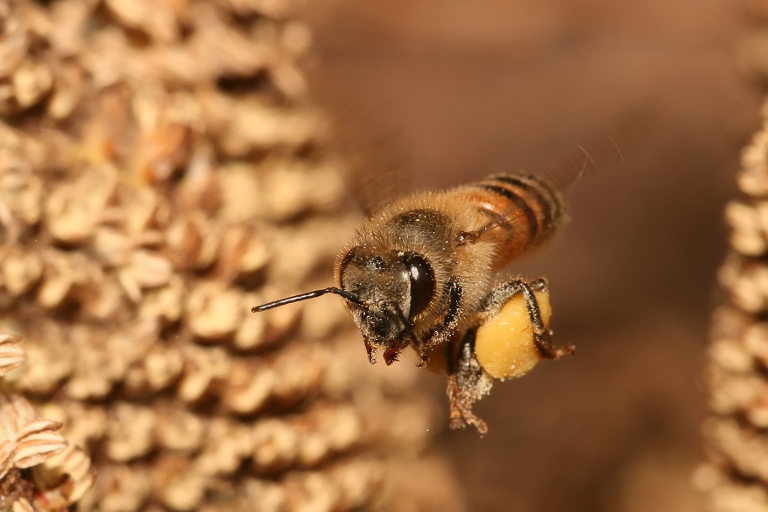Are you looking for a summer read? We share some of our favourite recent food and farming books.
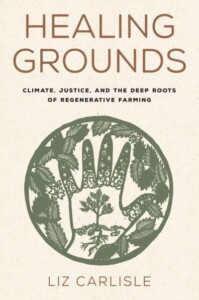
Healing Grounds: Climate, Justice, and the Deep Roots of Regenerative Farming, by Liz Carlisle.
Reviewed by Alicia Miller
Healing Grounds looks at alternate strategies for food production, reaching back to the indigenous cultures of the Americas and the diverse communities that have farmed land in ways that are not based around white supremacy.
Liz Carlisle proposes a radical challenge: how to effectively restore these long-standing regenerative practices to the foreground of agricultural production. Standing front and centre is soil and its health and Carlisle takes this as the starting point for her investigation into past histories and the current practices of farmers, ranchers and growers that are drawing on the cultures of Native Americans, African Americans, Asian Americans and Mesoamericans. She comments that
‘To my amazement, I found that practices commonly promoted within regenerative circles as new innovations had been used for many hundreds and, in some cases, thousands of years – not just in far-away ancient civilizations but continuously and right here on the North American continent.’
The journey starts with the reintroduction of the iconic buffalo and the work being done on the Blackfeet Reservation to make their historical migration across the plains possible again. Carlisle notes that, ‘By selectively grazing over long distances, buffalo helped create one of the most ecologically productive landscapes in North America.’ Their return to the land is an important step for Native communities, but what is also important is the recognition that buffalo as significant mega-fauna, could have a key role to play in sequestering carbon in the soil – more potently than cattle.
Healing Ground follows practices that have roots in cultures that have suffered. It tells the story of diverse people, struggling to recover what they have lost. From grower Olive Watkins’ forest land passed down from her grandmother – remarkable, given the long history of land taken from black farmers over centuries – using traditional agroforestry practices to farm it, to Aidee Guzman’s research into ‘three sisters’ Mesoamerican agriculture, and Asian practices brought by Hmong farmers to promote soil health, there is a wealth of knowledge to be had. These are stories of restitution and restoration, tied to enduring native practices that have resurfaced as something new, but the roots of which reach back into the deep histories of these cultures.

Eating to Extinction: The World’s Rarest Foods and Why We Need to Save Them, by Dan Saladino.
Reviewed by Isabel Eaton
In the emphatic words of journalist, and now award-winning author, Dan Saladino: “Where nature creates diversity, the food system crushes it.” Eating to Extinction is a passionate exploration of extraordinary foods from across the world, all of which have had their existence threatened by industrial farming methods, colonisation and globalisation. The book is part ode to the beauty, resilience and unique attributes of these rare ingredients, and part urgent call for change within an increasingly vulnerable and homogenous food system.
Across 10 topics, including wild foods, cheese and alcohol, Saladino offers detailed insights into remote landscapes and cultures, and the individuals and communities fighting to protect the foods that are found there. History, biology and anthropology are combined with evocative descriptions of flavours and scenery leaving the reader simultaneously anxious for the fate of our food and hungry to experience “the crisp bite and sweet coconut taste” of murnong root and to tread barefoot upon the potato-covered Bolivian Altiplano.
Many of the foods that Saladino describes must undergo arduous processing to render them edible, or they produce lower yields, or can only be found by those with honed foraging skills; but their nutritional value, natural resistance to pests and disease, cultural significance, and ability to grow in challenging conditions makes them worth the effort. Orkney’s Bere Barley, for example, takes three days to mill but grows fast in its harsh climate, and Hadza Honey requires extraordinary teamwork between humans and birds to locate it, but provides a vital fifth of the Hadza hunters’ calories.
Selective breeding for yield and convenience may have vastly increased the available calories for the growing human population, but it has also significantly narrowed the genetic range of foods eaten across the globe. With both famine and obesity crises in the news and the planetary costs of our farming methods rising ever higher, Saladino argues that we must learn from our rich history of farming and foraging to utilise the attributes of rare and ancient foods to increase food diversity and work in harmony with nature to create a more sustainable food system.
The reader is encouraged to rethink their own eating habits and expand their culinary horizons by eating a greater diversity of local plant species and animal products, both for the good of their own health and that of the environment. Don’t be surprised if the book leaves you questioning the sustainability of your choices when you next visit the supermarket or purchase seeds for your vegetable patch. Eating to Extinction shows that we all have a role to play in protecting rare foods and the planet.
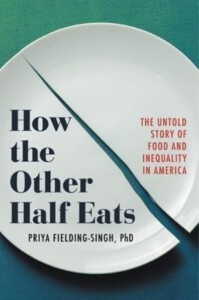 How the Other Half Eats: The Untold Story of Food and Inequality in America, by Priya Fielding-Singh
How the Other Half Eats: The Untold Story of Food and Inequality in America, by Priya Fielding-Singh
Reviewed by Bonnie Welch
If you have even a vague interest in nutrition, food access, inequality and the growing nutritional divide between rich and poor, you should definitely read How the Other Half Eats. More importantly, if you believe that individuals should be held solely accountable for poor food choices, obesity and diet-related ill-health, then this book is an absolute must.
American sociologist Priya Fielding-Singh deconstructs commonly upheld ideas around poverty, wealth, hunger and health, by sharing the day-to-day lives of four families, from varied educational, economic and ethno-racial backgrounds. Despite their differences, each of the parents documented in the book, share the desire to feed their families well.
In answer to the question, “How can we, as a society, ensure that all parents have the means necessary to nourish their children?”, Fielding-Singh concludes that access to healthy food is about more than geography and finances. Contrary to common wisdom (particularly in the US), which concludes that ‘food deserts’ are to blame for low-income families’ low-quality diets, Fielding-Singh finds that a multitude of broader social justice issues fundamentally shape what families eat.
“Every family should be able to comfortably afford and access the food they need and, in addition, have the time, energy, and bandwidth to cook and consume it,” argues Fielding-Singh. The concept of ‘bandwidth’ is particularly helpful when considering the capacity of parents to deal with the act of feeding their children. This seemingly straight-forward undertaking is significantly complicated by a number of challenging contexts, parental pressures, inadequate social policies and corporate interests.
One paragraph really brings this point home:
“Access to healthy food means not having to fight – to constantly struggle – to eat the food you want and deserve. It is one thing to be able to find and afford a head of cauliflower. But it is another to want to buy that cauliflower, to choose to spend one’s money on that cauliflower (at the expense of other purchases), to have the time and know-how to cook that cauliflower, and to possess the patience to weather one’s child’s complaints and pleas for macaroni and cheese and soldier on to feed that cauliflower to one’s child.”
Fielding-Singh concludes by making several important recommendations – including policy and structural reforms, and in the way we, as individuals, consider and talk about food choices.
“Together, we can shift the conversation around food and nutrition to assign less individual culpability and instead hold policy makers and corporations accountable.”
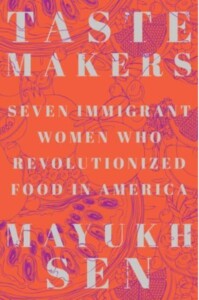 Taste Makers: Seven immigrant women who revolutionized food in America, by Mayukh Sen
Taste Makers: Seven immigrant women who revolutionized food in America, by Mayukh Sen
Reviewed by Imogen Crossland
Following the Second World War, the relaxation of American immigration laws saw an “influx of talented immigrant female chefs” to the country, from around the world. Taste Makers amplifies the voices of seven of these women, all of whom have shaped American food culture, despite most not remaining (or ever being) household names.
Mayukh Sen is careful not to label these women as ‘forgotten’ in a patronising sense, but instead dedicates a chapter to each, simply aiming to tell their stories in their own, honest voices (using extensive archival research and interviews to inform the narrative). Many became involved with food through necessity: moving to an unknown country stirred Marcella Hazan to recreate the Italian dishes of her childhood, while Mexican-born Elena Zelayeta learnt to cook after accepting her new life as a married woman. Yet the strength and passion with which each take control of their identity as a chef or food writer is clear, and the challenges they face in the process are often all too similar.
Central to these challenges is the power and influence of the American ‘Food Establishment’- the collection of restaurant critics and journalists from institutions such as the New York Times. Craig Claiborne among others possessed the power to make or break the careers of aspiring chefs – including those featured in this book. These women all had to battle against both the Food Establishment and the nation’s narrow-minded view of non-American (and perhaps also French) cuisine, although not all of them shared the ambition of addressing a white American audience. An interlude chapter on the American TV chef Julia Child acts as an interesting reference point to explain how her adoption into American food culture was comparatively seamless.
Through bringing to light the individual and collective impacts of these seven women, Sen beautifully demonstrates the concept of food diplomacy – that food can be used as a medium to promote understanding between cultures. Take Chao Yang Buwei, who, like the majority of Chinese immigrants in the 1940s, faced discrimination and battled the stereotype that Chinese food was ‘unclean’. Buwei’s cookbook “How to cook and eat in Chinese” (1945) changed America’s perception of Chinese food, coining terms we all know such as ‘stir fry’, but it also contributed to a broader understanding of Chinese culture, for which it was suggested she deserved a Nobel Peace Prize.
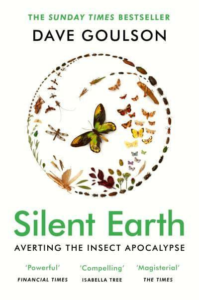
Silent Earth: Averting the Insect Apocalypse, by Dave Goulson.
Reviewed by Alicia Miller
Silent Earth is an important and profoundly sad read for anyone who cares about the future of our food and the survival of our planet. Insects sit at the base of the food web, supporting a vast array of birds and animals, playing a key role in pollination and helping to disperse seeds, and cleaning up the muck and detritus of world. Without them, it would be difficult to survive on our planet. Goulson comments that ‘As insects become more scarce, our world will slowly grind to halt for it cannot function without them.’
Insects, as people are increasingly aware of, are in decline – possibly catastrophic decline. Goulson suggests by 75% or more since the 1970s. Silent Earth takes a hard look at what is happening, and finds that mainly, it is ‘death by a thousand cuts’. The root of insect decline is unquestionably connected to us, to humans, and in large part to how we live on the earth and, in particular, how we farm and eat and in the chemicals that we use everywhere in our lives. Agriculture bears a significant responsibility for their decline with its heavy use of pesticides, herbicides, fungicides and neonicotinoids. We may pay a vast price for their loss as a result.
At the start of Silent Earth, Goulson reckons that people mostly don’t like insects. Those encountered in cities where most people live are seen as pests – spiders, cockroaches, flies, ants, clothes moths and silverfish. But it is imperative that humans garner a greater understanding of how important they are to our own survival, let alone the survival of the wider flora and fauna that populate the world. Each chapter opens with a description of an insect – short tales to marvel the reader with the wonder of what they do: the Bombardier Beetle that shoots a painful mix of chemicals out its rear when under attack; the co-dependent Leafcutter Ants which tend the fungi that feed them; the Earwig with two penises.
The book closes with a vision of our future with fewer and fewer insects and as a result, fewer and fewer birds and animals and a wholly degraded world. Goulson’s description of what our future could hold, should make us quake in our boots.
And don’t miss…
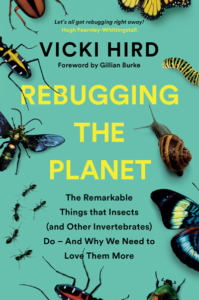
Reviewed by Alicia Miller
Rebugging the Planet is full of wonder and appreciation for the small things that inhabit our world and make it work. Bugs are some of the most important things on earth, but they are easy to dismiss, forget and step on. What many of us don’t know, however, is that our lives, quite literally, depend on them.
After the desolation of Dave Goulson’s Silent Earth, Vicky Hird is there to pick you up and remind you that there is a lot that you can do to ensure that these creatures thrive. Understanding insects better is a good place to start and she details a litany of marvels: she tells us that a spider’s thread is comparable to high-grade alloy steel; that there’s an algorithm which developed out of ant behaviour; and that the Scarab beetle can navigate using the milky way.
The book is full of suggestions for how we all can help support our bugs and it is fun and easy to read. Hird’s own joy in bugs is infectious and underpinned by the deep respect these creatures deserve.
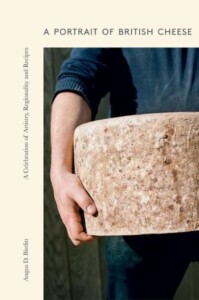 A Portrait of British Cheese, by Angus D. Birditt.
A Portrait of British Cheese, by Angus D. Birditt.
Presented by Megan Perry
A Portrait of British Cheese celebrates the excellence of artisan and farmhouse cheese in the British Isles, showing how British artisan cheese is profoundly connected to the land, farm animals and people involved in making it. Shining a light on the industry’s rich heritage, community and, above all, its cheesemakers, photographer and writer Angus D. Birditt has been visiting and documenting dairies all over the British Isles looking at how, through a mixture of knowledge and intuition, science and artistry, they create their cheese. The book details a selection of thirty small-scale cheesemakers and their cheeses, revealing the joys and challenges of a life in cheesemaking through photos, essays, and recipes. A Portrait of British Cheese is a unique journey through Britain’s artisan and farmhouse cheeses and producers, with recipes, so you can explore small-scale producers and learn how the cheesemakers themselves like to enjoy their cheese, from using it in traditional, regional dishes or family favourites, to eating it with the best seasonal produce.
Teaser photo credit: By Muhammad Mahdi Karim – Own work, GFDL 1.2, https://commons.wikimedia.org/w/index.php?curid=6699147


